Best rabbit-repellent plants: 14 top choices for your yard
Keep bunnies at bay with these rabbit-repellent plants and deter them from eating their way through your favorite blooms
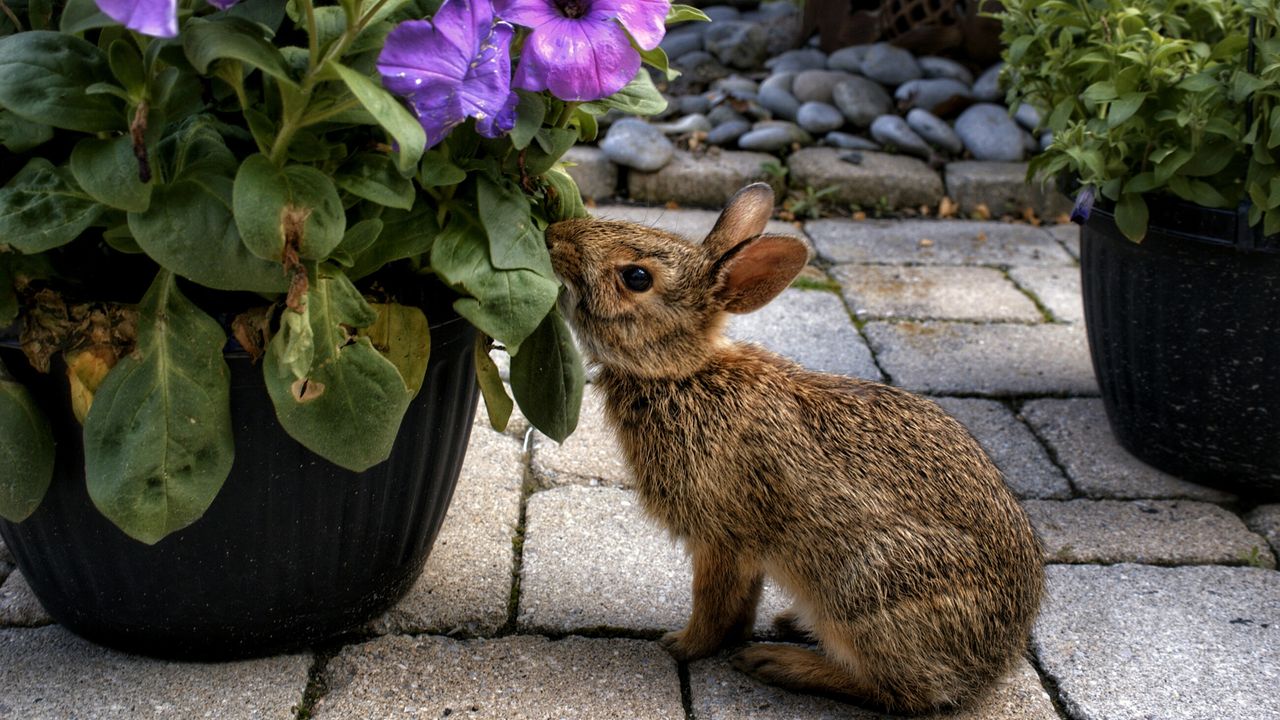

Rabbits may be cute, but they can do a lot of damage in the garden. Rabbit-repellent plants will put a stop to discovering that they have munched their way through the succulent leaves of your favorite plants. Which is enough to make anyone want to tear their hair out!
If they find foliage that’s tasty – such as the emerging young growth of annuals and perennials in spring – they can make light work of your flower borders or your vegetable patch, costing you a lot of time and money.
Thankfully, there are many plants they find unappetising or repellent. Grow a generous amount of these rabbit-resistant plants to keep your borders safe from bunnies.
And once combined with a few mosquito-repellent plants you'll find you can have a yard which is free from pests of all shapes and sizes.
Keep your garden safe from bunnies with these rabbit-repellent plants
For those of us whose backyards are plagued by rabbits, you'll be thankful for these varieties of rabbit-repellent plants that are not only immune to munching, but also look great in a variety of planting schemes.
While we can't promise they are completely effective as a method for keeping rabbits out of your garden or yard, it hopefully means your flowerbeds won't be destroyed when they do get into your garden.
1. Lavandula angustifolia ‘Purity’
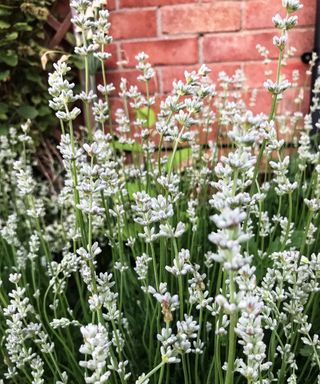
- Hardiness: USDA 5-8 (UK H5)
- Height: 15in (40cm)
- Spread: 24in (60cm)
- Best for: Pollinators
You can never have enough lavender in your garden and the more the better if rabbits are a pest in your area. While we may love the delicious aroma of the ever-gray leaves and the flowers that fills the air on warm days, rabbits dislike the smell.
Using a compact variety – such as the elegant white-flowered ‘Purity’ – to grow a low hedge around flower borders is an excellent way to keep rabbits away from your precious perennials. As an added bonus, lavender is also one of a few useful plants that repels insects. Grow them in very well-drained soil in sun.
2. Rosa glauca Pourr
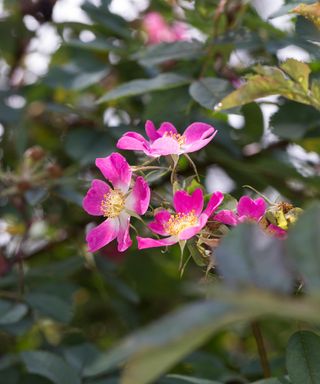
- Hardiness: USDA 2 to 8 (UK H7)
- Height: 6ft (1.8m)
- Spread: 5ft (1.5m)
- Best for: Rose hips
If rabbits are an issue for you, varieties with soft foliage are best avoided, as is the case if you are also looking for deer-resistant plants. Thorny roses are not a tempting meal for rabbits and create an effective barrier between them and plants they are partial to.
This fabulous species shrub rose produces carmine-pink blooms in summer that feed bees and contrast beautifully with the rich-red stems and mauve-gray leaves.
In fall, they are followed by a mass of red hips that feed birds. Grow alone or train it into a hedge. Best in humus-rich well-drained, retentive soil in sun, but tolerant of poor soil and semi-shade.
3. Tagetes 'Lemon Gem’
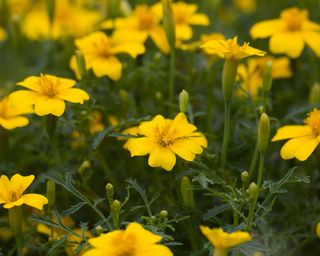
- Hardiness: All zones
- Height: 10in (25cm)
- Spread: 10in (25cm)
- Best for: The vegetable patch
Marigolds are excellent rabbit-repellent plants as bunnies dislike the wonderful pungent smell. For that reason, they work brilliantly as edging plants for a border or vegetable patch, in order to guard the growth within.
The aromatic leaves are topped with red, orange, or yellow flowers from late spring into fall.
They can be grown from seed or bought as bedding plants; the single forms are preferable, as the double-flowered varieties can look dated and don’t provide for pollinators. ‘Lemon Gem’ is a neat Mexican form that is a mass of yellow flowers for months.
4. Stachys byzantina
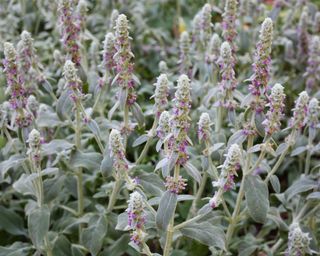
- Hardiness: USDA 4-8 (UK H7)
- Height: 20in (50cm)
- Spread: 20in (50cm)
- Best for: Texture
Plants with hairy or downy foliage are unappetising to rabbits, and lamb’s ear is one of the best for the front of the garden border. Its attractive woolly silver leaves make for one of the best foliage plants available, they are ever-gray and topped by silver and pink flowers in summer.
It's a great perennial ground cover plant for dry, sunny parts of the garden and a fascinating wildlife plant, since it attracts the very territorial male wool carder bee, who insists that female bees visiting to take the leaf wool to line their nests must mate with him!
5. Stipa tenuissima
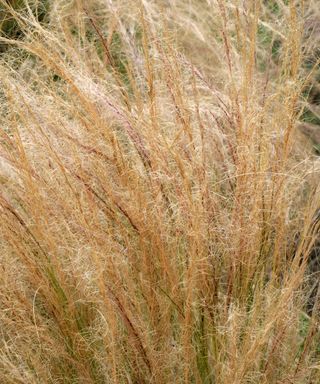
- Hardiness: USDA 7-10 (UK H4)
- Height: 2ft (60cm)
- Spread: 1ft (30cm)
- Best for: Contemporary gardens
Rabbits dislike the texture of coarse, wiry types of ornamental grass, such as stipa and miscanthus. The Mexican feather grass is a great evergreen choice for the front of the border, where it will seed itself in the right conditions.
The hair-like tufts and green-blonde plumes billow on the breeze, creating lovely movement and an informal, modern look all year round.
Plant in very well-drained soil in full sun and don’t feed or mulch, as it prefers poor soil.
Grasses are also a good option if you're searching for slug-resistant plants.
6. Buxus sempervirens 'Elegantissima'
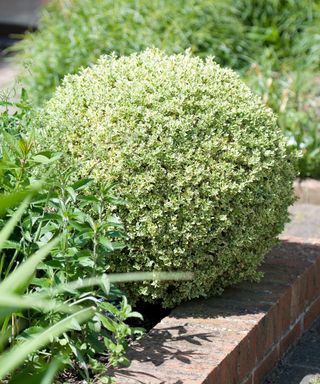
- Hardiness: USDA 5-8 (UK H6)
- Height: 5ft (1.5m)
- Spread: 5ft (1.5m)
- Best for: Low hedging
Although the distinctive verdant fragrance of boxwood leaves is appealing to us, they make great rabbit-repellent plants. They usually dislike the smell, especially when it hangs in the air on sultry summer days. Clip it into a miniature hedge to edge borders, in order to deter rabbits.
Grow the lovely variegated form ‘Elegantissima’ in well-drained soil in semi-shade. To prevent box blight, trim in late summer every year in dry weather, disinfect shears, clip a convex top, mulch annually, and always water from below.
7. Cistus ladanifer L.
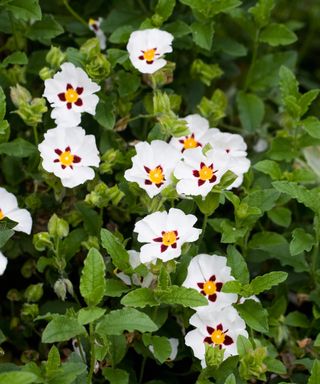
- Hardiness: USDA 6-9 (UK H4)
- Height: 5ft (1.5m)
- Spread: 5ft (1.5m)
- Best for: Scent
The incredible musk aroma produced by the sticky leaves of the labdanum rock-rose is overpowering for rabbits, who give it a wide berth. Being evergreen and covered in large saucer-shaped white flowers during the summer months, it is a great shrub for the back of the border, especially in front of hedges that rabbits hop through.
Being native to the wild, scrubby maquis of the Mediterranean, cistus varieties are drought tolerant and love well-drained, poor (low nutrient) soil in sheltered full sun.
8. Nepeta racemosa 'Walker's Low’
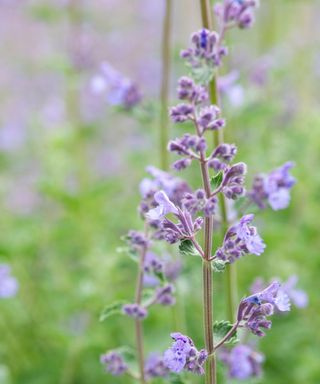
- Hardiness: USDA 4-8 (UK H7)
- Height: 2.5ft (75cm)
- Spread: 1.6ft (50cm)
- Best for: Bees
The silver-green foliage of catmints releases a caramel tang that rabbits turn their noses up at. ‘Walker’s Low’ is one of the best varieties, having purple-blue blooms on dark stems.
Like all catmints, as well as being a delightfully fragrant plant, it attracts lots of bees when it flowers in summer; cut spent stems back to encourage more flowers.
Grow in well-drained soil in sun or semi-shade and don’t over feed because the plant will become floppy (and require staking) in overly rich soils.
9. Allium schubertii
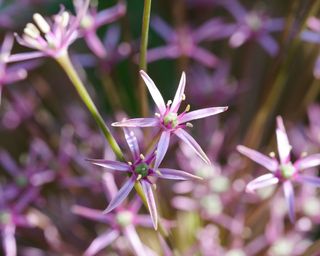
- Hardiness: USDA 5-8 (UK H4)
- Height: 20in (50cm)
- Spread: 12in (30cm)
- Best for: Seedheads
Not only do rabbits dislike the onion-scented leaves of alliums, but their architectural flowerheads add color and structure to borders in early summer and provide fabulous seedheads for winter and for cut-flower displays.
The flowerheads of Schubert’s allium can reach a whopping 12in (30cm) or more, and their pink-purple flowers and wine-colored stems make them look like exploding fireworks at the front of the border. Plant the bulbs in fall, 6in (15cm) deep, in well-drained soil in sheltered sun.
10. Papaver somniferum
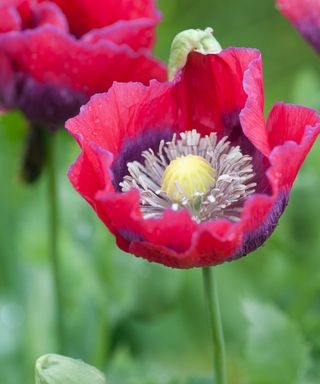
- Hardiness: USDA 4-10 (UK H5)
- Height: 3ft (90cm)
- Spread: 1ft (30cm)
- Best for: Color
Being toxic, opium poppies are avoided by bunnies, but as well as being great rabbit-repellent plants they are fabulous annual flowers, either for filling gaps in borders with bold color or for prettifying a scrubby patch of ground. In summer, they bloom in bright shades of plum, red, pink, and purple above glaucous leaves.
They will self-sow with gusto in the right conditions, so deadhead flowers (wearing gloves) if you don’t want more the following year. Sow direct in spring in very well-drained, poor (low nutrient) soil in full sun.
11. Cleome hassleriana
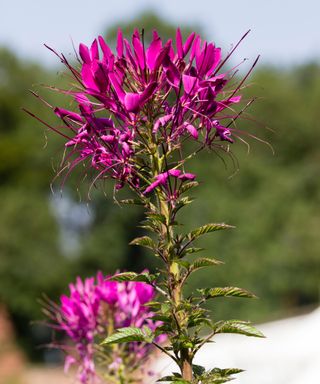
- Hardiness: All zones
- Height: 5ft (1.5m)
- Spread: 20in (50cm)
- Best for: Exotic flowers
Every visitor will ask what the spider flower is when it blooms in your garden in late summer and fall. The incredible exotic-looking pink, mauve, and white flowers open atop statuesque spiny stems and look like jungle plants.
The only visitors who won’t be interested in this annual are the rabbits, who dislike the aroma and the thorns.
Sow undercover in late winter or early spring, in retentive, well-drained soil in full sun, in order for these rabbit-resistant plants to be ready for the garden in late spring or early summer.
12. Origanum laevigatum ‘Herrenhausen'
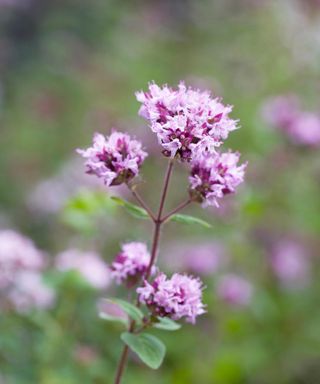
- Hardiness: USDA 5-9 (UK H6)
- Height: 18in (45cm)
- Spread: 3ft (60cm)
- Best for: Butterflies
Butterflies and bees – but not rabbits – flock to the purple-pink flowers of this ornamental oregano. This pretty plant for pollinators opens from claret bracts throughout summer. The wonderful Mediterranean stench of the aromatic leaves hangs in the air on still, warm days, putting off our cotton-tailed friends.
Plant this perennial in light, well-drained neutral to alkaline soil types in sun, in a sheltered spot to lure more butterflies. Excellent at the edge of the border or atop walls.
13. Echinops bannaticus 'Taplow Blue’
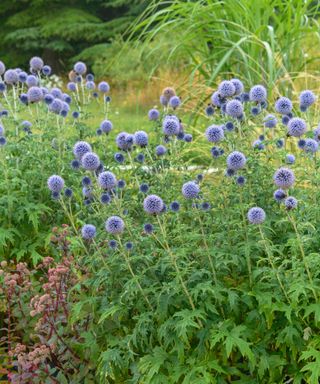
- Hardiness: USDA 3-8 (UK H7)
- Height: 5ft (1.5m)
- Spread: 2.5ft (75cm)
- Best for: Architectural impact
Bunnies don’t appreciate the prickly green leaves of globe thistles and so avoid these superb border perennials. In dry, sunny borders, they are indispensable, producing stunning spheres of silver-blue flowers that feed bees and butterflies in late summer and early fall.
These continue to add architectural structure once they have morphed into one of the best plants for seed-heads in late fall, thus providing interest for months. Plant in very well-drained, poor soil in sun at the back of the border.
14. Verbena bonariensis
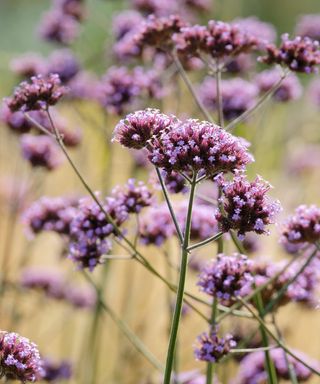
- Hardiness: USDA 7-11 (UK H4)
- Height: 7ft (2.1m)
- Spread: 18in (45cm)
- Best for: Flower power
A unique and spectacular perennial that rabbits hop away from. In summer and fall, purple top is an airy mass of small amethyst flowerheads on many slender branching stems.
It is useful in the middle of a border, since it allows the plants behind to be glimpsed, thus creating an attractive layered effect. In well-drained soil in sun, this short-lived perennial will self-sow, providing you with lots of free plants. Wear long-sleeves and gloves to handle it, as the foliage can irritate skin.
What repels rabbits from eating plants?
Rabbits dislike plants that are hairy or felty (lychnis and lamb’s ear make great rabbit-repellent plants for example), poisonous (foxgloves and monkshood), or spiny (including roses and globe thistle), as well as foliage that is coarse, dense, or wiry (for instance, red hot poker varieties and miscanthus).
However, be warned that when young growth is emerging in spring, the leaves of many plants that rabbits are usually uninterested in can be softer and less toxic and thus may be nibbled by them.
Therefore, if rabbits are a regular pest in your garden, spring is the main time to put up temporary protection, such as rabbit fencing or wire cloches, until plants are established. Likewise, protect the trunks of young trees during their early years.
Taking the time to erect decent wire fencing all around the garden is of course the most effective approach, but if it is impossible to stop them entering, growing plants they dislike will help. You can also scare them by hanging things that make noise or reflect light when the wind blows, such as CDs, tin cans, or wind chimes.
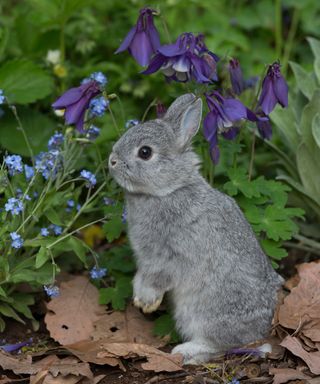
Strongly scented plants are disliked by rabbits
What plant smells will keep rabbits away?
Rabbits dislike pungent aromas, including those released by lavender, rosemary, nepeta, and cistus. Because the scent is strong, it will deter them from eating the leaves, keeping your plants safe. Edging a flower border or vegetable patch with a hedge of one of these aromatic plants is a great way to guard the plants within.
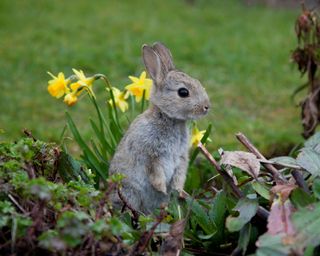
Put up temporary plant protection from rabbits in spring
Will coffee grounds keep rabbits away?
Coffee grounds are said to be unpleasant to rabbits, who dislike their smell and caffeine content. They are also said to be a good option for getting rid of slugs, although so far there is no scientific evidence to prove this. But if you drink a lot of coffee and either rabbits or slugs plague your garden, it’s worth a go!

Teresa has worked as an Editor on a number of gardening magazines for three years now. So she is lucky enough to see and write about gardening across all sizes, budgets and abilities. She recently moved into her first home and the garden is a real project! Currently she is relishing planning her own design and planting schemes. What she is most passionate about when it comes to gardening are the positive effects it has on our mental health to grow and care for plants, as well as being great for the environment too and help provide food and shelter for wildlife.
